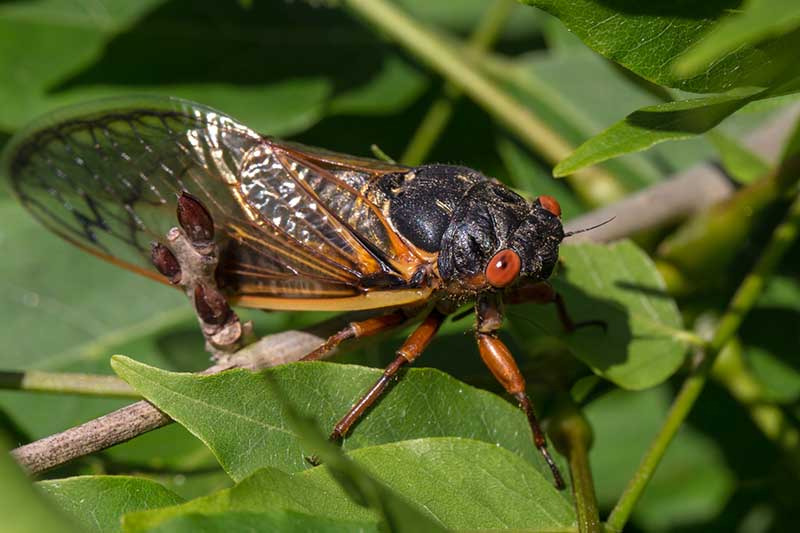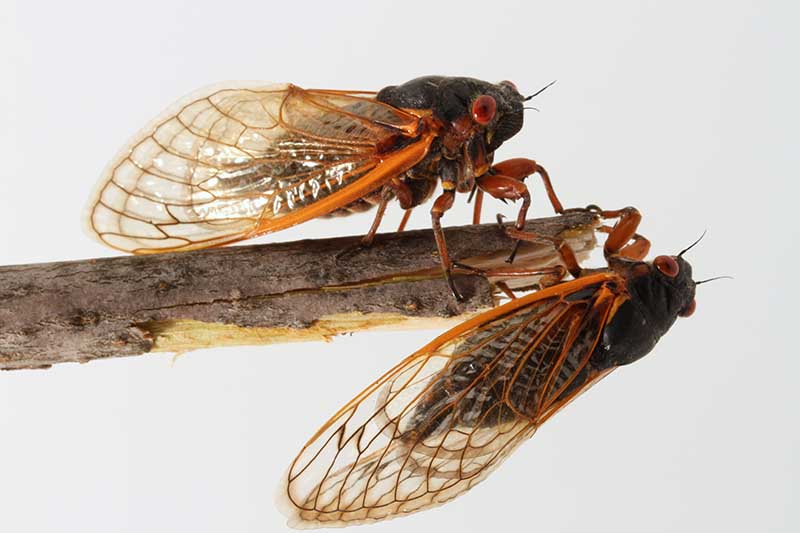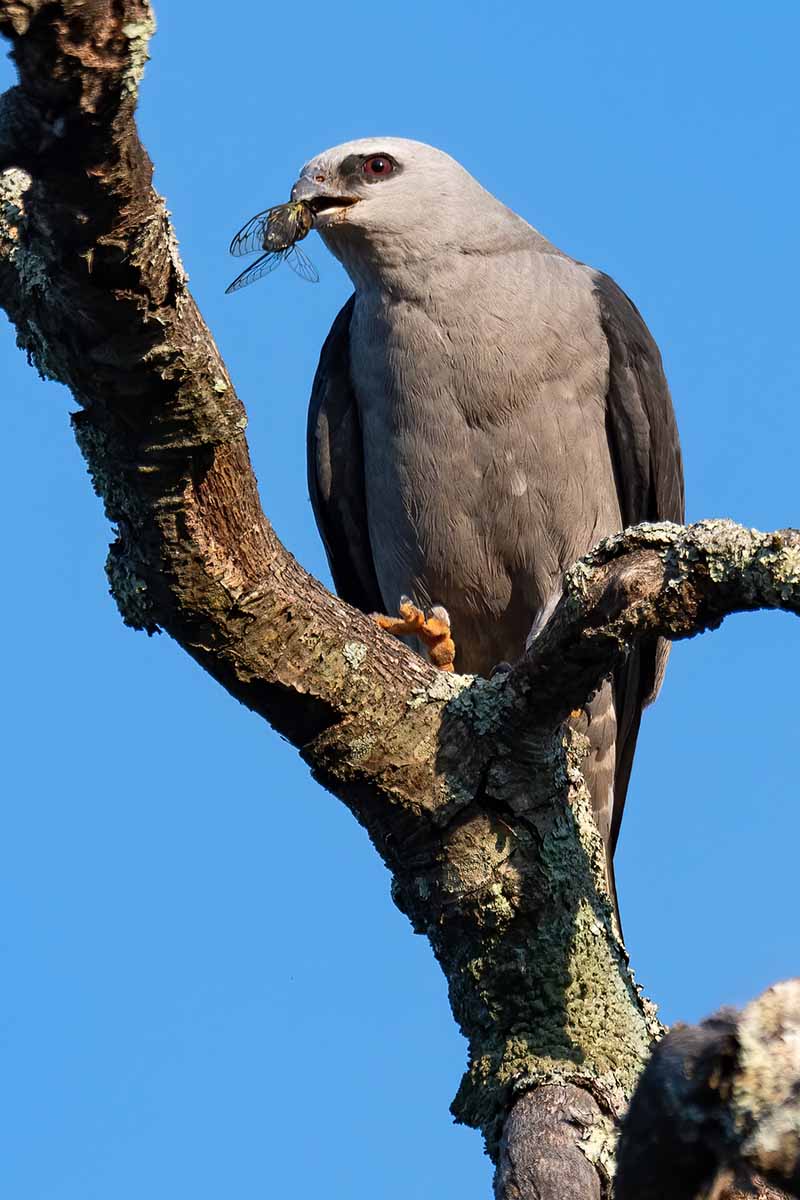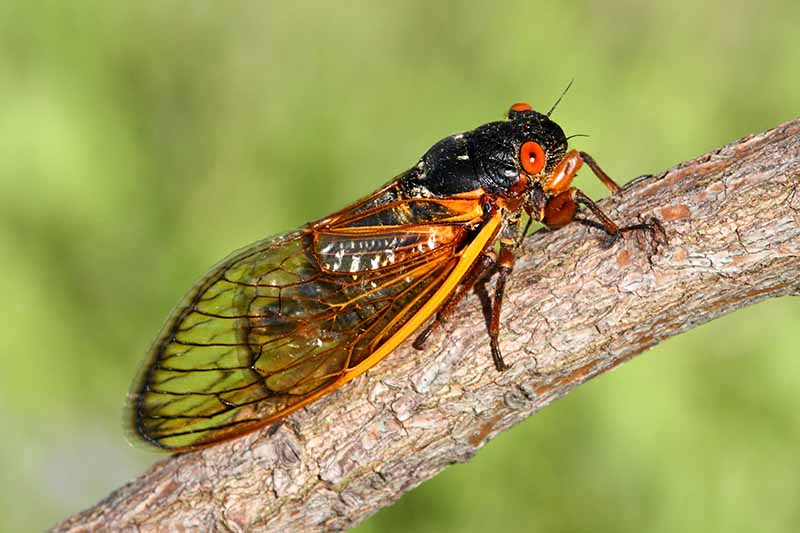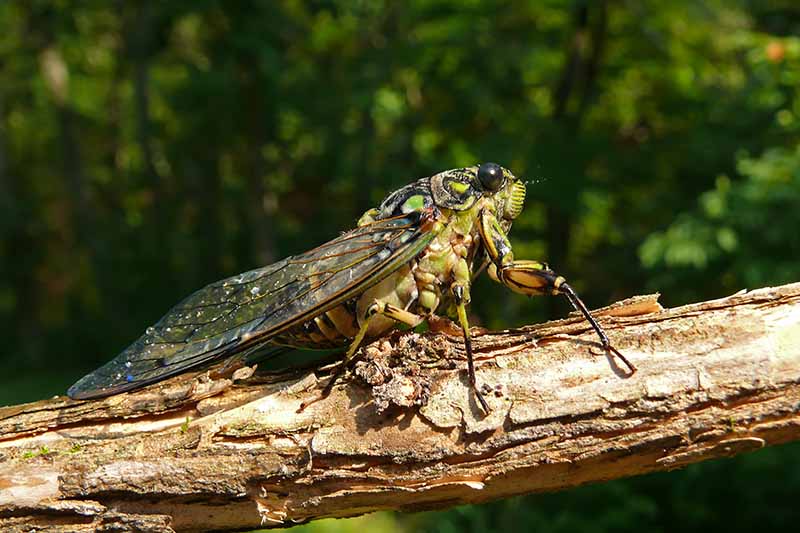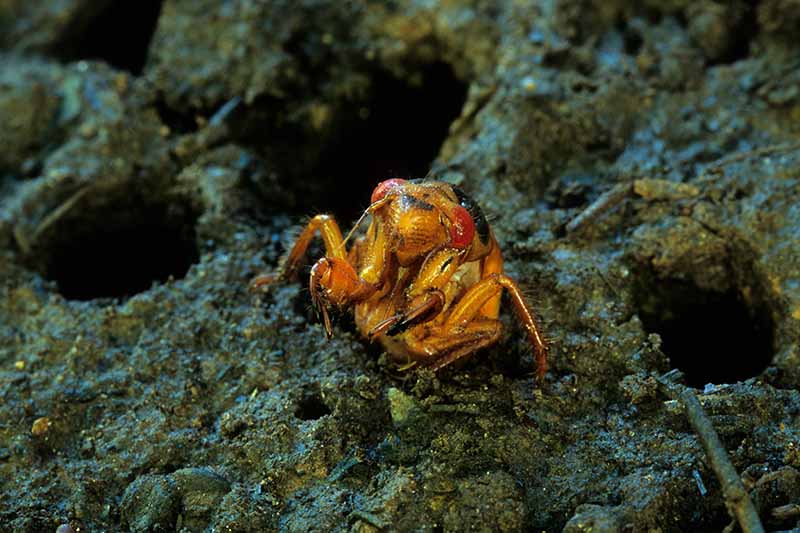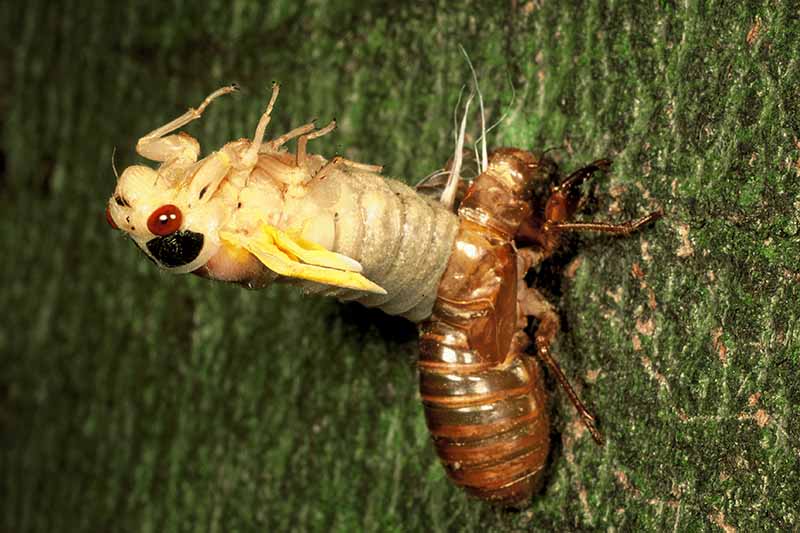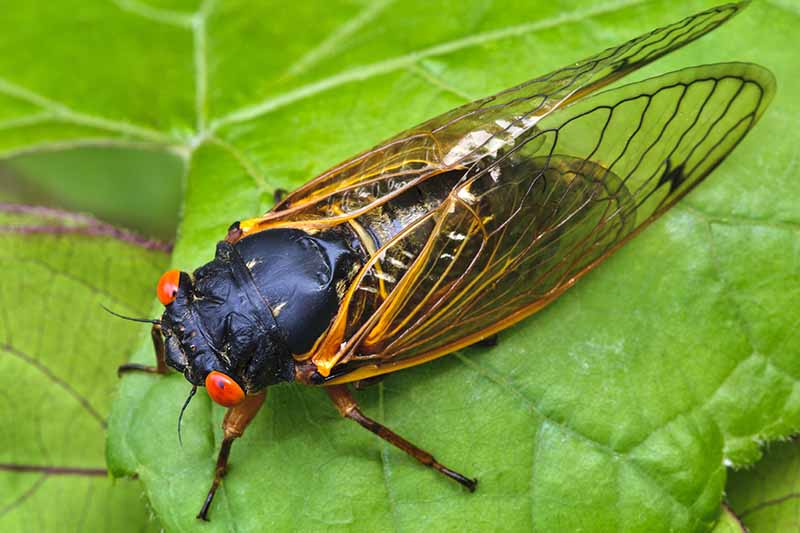Somehow, hearing their shrill solos made the sun seem even hotter than it was. But we aren’t talking about those annual summertime vocalists in this article. We’re talking about the miracle of periodical cicadas, when every 13 or 17 years, thousands of these noisy bugs emerge in the late spring, and sing all at once. We link to vendors to help you find relevant products. If you buy from one of our links, we may earn a commission. These bugs do suck plant juices and lay eggs in tree branches, so you may wonder what this massive emergence means for your garden. Here’s what we’ll cover:
What Are Periodical Cicadas?
Cicadas are bugs from the Cicadidae family and one of the many types of plant sucking insects that make up the Hemiptera, or true bug, order. People often refer to any type of insect as a bug, but the term “true bug” is actually reserved by entomologists for insects with piercing-sucking mouthparts and “half-wings,” where a part of one pair of wings is tough, a part is membranous, and the second pair is also membranous. The type that sang through the summers of my childhood are dog-day cicadas (Tibicen spp.), and these appear annually. Periodical cicadas belong to seven species in the Magicicada genus that have synchronized life cycles, meaning all or nearly all members of a species emerge from the ground as adults one year, and are completely absent otherwise. Three Magicicada species surface every 17 years, and these are mainly distributed in more northern areas of North America. Four species emerge every 13 years and have a more southern distribution. Magicicada septendecim, or the pharaoh’s cicada, M. septendecula, the decula periodical, and M. cassini, the dwarf periodical or Cassini periodical, are the three 17-year cicadas. The 13-year cicadas include M. tredecim, or the 13-year decim; M. neotredecim, aka John and David’s cicada; M. tredecula, or the 13-year decula; and M. tredecassini, aka the 13-year Cassini. Native to and occurring only in eastern North America and areas bordering on the Midwest, these large insects emerge over one to two nights in late May to early June, filling the trees with their loud choruses. In 1893, a numbering system to track and predict the timing of the phenomenon was established. Those that emerge in a given year are known as a single “brood.” Each brood is assigned a Roman numeral. There are 12 broods of 17-year, and three broods of 13-year species. For example, Brood X, the Great Eastern Brood, surfaced in 2021. The Northern Illinois Brood (XIII) and the Great Southern Brood (XIX) are both expected to emerge in 2024. Knowing exactly when the large appearances will happen is handy for implementing control measures, or if you want to visit a specific area to experience this amazing event. Check out the University of Connecticut’s cicada website to find out where and when the next one will happen. Of course, there are always late bloomers. Often emerging one or four years before or after they are expected to, these stragglers and their choruses can be a surprise. These bugs are xylem feeders, which refers essentially to a type of plant vein that is mainly responsible for transporting water absorbed by the roots to the rest of the plant. This low-nutrient diet is thought to be part of the reason why the life cycle of these insects is so long. The main reason, though, is predator avoidance, as these bugs are a favorite snack of birds.
Periodical Cicada Identification
One and a half inches long, Magicicada bugs are generally smaller than annual species, which can be up to two and a half inches long. Initially, after molting, the adults are pale colored. As the exoskeleton hardens, their bodies turn black. They have red or orange eyes, clear wings, and red-orange wing veins. The females have a sharp ovipositor (egg depositing organ) and the males buzz shrilly. Annual bugs have green eyes and greenish wing veins, and emerge from July to September. Thanks to the variation in color, it is easy to tell the difference between annual and periodical species.
Biology and Life Cycle
Nymphs live two to 24 inches deep in the soil, feeding on tree roots. The year they are supposed to emerge, they burrow up to an inch below the soil surface, sometimes pre-building an exit tunnel in damp soils to help them emerge on time. The tunnels created by emerging nymphs help to aerate the soil. Right on cue, when spring soil temperatures reach 64°F, they all emerge together and immediately crawl about a foot up anything vertical – like a tree trunk or plant stalk nearby – to molt. The nymph’s skin splits down the back and a sexually mature adult emerges with a pale, soft exoskeleton. The birds love to feast on cicadas at this stage, gobbling them up by the hundreds. Sometimes people like to eat them, too! After a few hours, the exoskeleton is hard and black and the bug can fly, although clumsily. Aggregating in dense groups called leks in high, sunlit branches, the males begin to sing, attracting the females for mating. John and David’s cicada was named after John Cooley and David Marshall, who discovered the mating ritual of these insects is actually more complicated than simply emitting that distinct, shrill song. In response to the first note of the males, the females flick their wings, encouraging the male to sing three more notes that sound like they’re saying “phaaaroah.” Another wing flick excites him into a round of “te te te,” and mating begins. A week to 10 days later, egg laying, or oviposition, begins. The females slice pockets into the wood of branches, preferring those that are pencil width to half an inch in diameter. Each adult female will lay a couple dozen eggs in each branch, and can lay up to 400 eggs total over the course of a month. The eggs hatch after six to seven weeks, and tiny white nymphs that look a little like ants fall to the ground. These burrow into the soil and begin to feed on plant roots for the next 13 or 17 years before emerging as mature nymphs to start the entire cycle again. The adults die after mating and oviposition, and their bodies drop to and litter the ground. Seeing so many large, dead insects can be disturbing, but the bodies decay into the soil, providing nutrients that can be used by the trees and surrounding plants. Oviposition is focused on trees and bushes. It can cause flagging on trees, which is when peripheral branches wilt, turn brown, and die. The damage also provides potential entry points for fire blight, a common fruit tree disease. Deciduous trees, fruit trees, and grapevines are most often affected. On the other hand, for many types of healthy, mature trees this is considered a healthy and natural form of pruning, and trees will even produce more flowers and fruits the next year as a result! There is no need to worry about your vegetables, flowers, or yourself. Cicadas target deciduous hardwood trees to suck on and lay eggs in, and although their long mouthparts and sharp ovipositors look threatening, they don’t bite. So just sit back and enjoy this incredible event.
Monitoring
Thanks to the brood numbering system, it is easy to find out in exactly what years an emergence will occur, and you can stay a step ahead of them if you have young trees on your property. The pre-dug emergence tunnels the nymphs create can also help you determine exactly where they will be surfacing. The holes are about half an inch in diameter, and will appear in the spring a few weeks before soil temperatures are ideal and emergence occurs. If you miss these signs, the females don’t start laying eggs until about a week after the males start buzzing, so you still have time to implement protective controls once you hear their songs start.
Organic Control Methods
Cultural, physical, and biological controls are all part of a good integrated pest management (IPM) strategy, and you can learn more about IPM and how to use it here. Most mature trees will recover from oviposition damage without detriment. In the month after the main oviposition event, the numerous dead and dying peripheral branches and tips may make it look like the tree is struggling, but the damage is typically mainly cosmetic and will not last beyond the season. Concentrate control methods on trees younger than four years. Immature trees have many branches within the preferred diameter, so these may see more damage and struggle more to recover than bigger, mature trees.
Cultural Control
Consider not transplanting trees during the fall and spring before a predicted emergence, as a large amount of damage soon after planting can affect successful establishment and vigor, and transplanting can already be stressful for trees. Avoid pruning before an emergence as well. Stressed young trees can be killed by large amounts of damage. If you wish, prune off dying branch tips once the cicadas have finished laying eggs, to remove decaying material.
Physical Control
Physically excluding these bugs from your young trees is the most effective way to avoid damage. Use netting or screen material with a weave that is one centimeter wide or less – try a mosquito screen or cheesecloth. Cover young trees and bushes, securing the mesh around the trunk to prevent them from crawling up and underneath it. Wrap the trees before the bugs emerge and keep it on for four to six weeks after they appear. This is more effective than pesticides, especially in home gardens and small plantings. You can use a tree wrap on the trunks of larger trees to prevent the nymphs from crawling up, as described in our article on how to avoid cicada tree damage.
Biological Control
Natural predators include birds, which love these noisy critters. The mass emergence is quite a treat for them, and fish will gorge on bugs near streams and ponds as well. There are so many cicadas emerging at once that the birds and fish often can’t keep up! Another natural enemy, Massospora cicadina, is a fascinating fungal parasite that affects the cicada’s sexual signals. This is the only known pest that is synchronized to their life cycle. Infected bugs can be described as “live zombies.” Ill males flick their wings as females do during the mating ritual, attracting other males and females alike. This increases exposure to and spread of the fungus. The fungus produces spores inside the infected cicada, forming a mass on the end of the abdomen which makes the males infertile and the females unable to deposit eggs. Eventually, it kills the bug. These spore masses fall to the soil to infect the nymphs as they begin their life cycle underground. The disease emerges with the nymphs after 13 or 17 years.
Organic Pesticides
Though pesticides such as pyrethroids can be effective in reducing oviposition, repeat sprays as often as every two or three days may be needed as more bugs move in from surrounding trees and forests. You can mix up a batch in your backpack sprayer, and spray the entire tree to form a protective layer on the surface. Any leftovers can be stored for up to two weeks. Reapply every seven days, or after rainfall. Surround WP Kaolin Clay Make sure you shake the container well before applying as the clay will settle out over time. You can find kaolin clay under the product name Surround WP at Arbico Organics.
Chemical Pesticide Control
For home gardeners, chemicals are not nearly as effective as using a physical barrier like netting. Plus, chemicals can kill beneficial insects that will keep more serious pest insects in check, such as summer spider mite populations. Have you ever experienced a periodical cicada emergence? Are you expecting an emergence this year in your area? Have you ever noticed damage on your trees as a result? Tell us about it in the comments below! And for more information on garden pests, have a read of these guides next:
Managing the Aphid: An Unwelcome Garden VisitorDoing Battle with Stink BugsHow to Manage a Spotted Lanternfly Infestation

